2018 KIA K900 brake fluid
[x] Cancel search: brake fluidPage 435 of 544
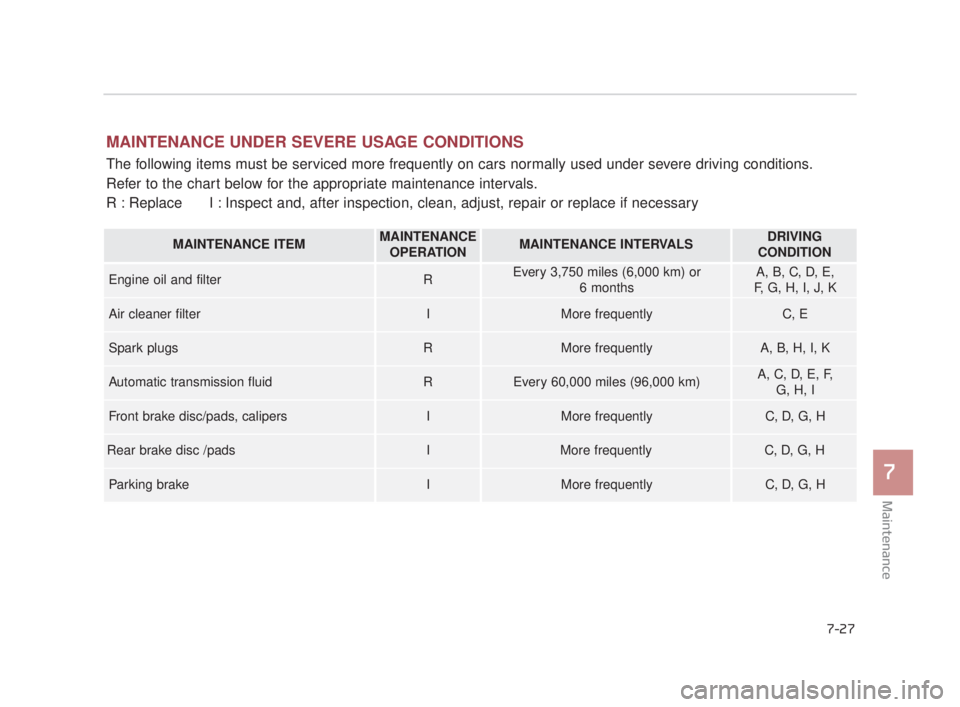
Maintenance
7
7-27
MAINTENANCE UNDER SEVERE USAGE CONDITIONS
The following items must be serviced more frequently on cars normally used under severe driving conditions.
Refer to the chart below for the appropriate maintenance intervals.
R : Replace I : Inspect and, after inspection, clean, adjust, repair or replace if nece\
ssary
MAINTENANCE ITEMMAINTENANCEOPERATIONMAINTENANCE INTERVALSDRIVING
CONDITION
Engine oil and filterREvery 3,750 miles (6,000 km) or 6 monthsA, B, C, D, E,
F, G, H, I, J, K
Air cleaner filterIMore frequentlyC, E
Spark plugsRMore frequentlyA, B, H, I, K
Automatic transmission fluidREvery 60,000 miles (96,000 km) A, C, D, E, F, G, H, I
Front brake disc/pads, calipersIMore frequentlyC, D, G, H
Rear brake disc /padsIMore frequentlyC, D, G, H
Parking brakeIMore frequentlyC, D, G, H
KH USA 7:2018 4/14/2017 6:37 PM Page 27
Page 438 of 544
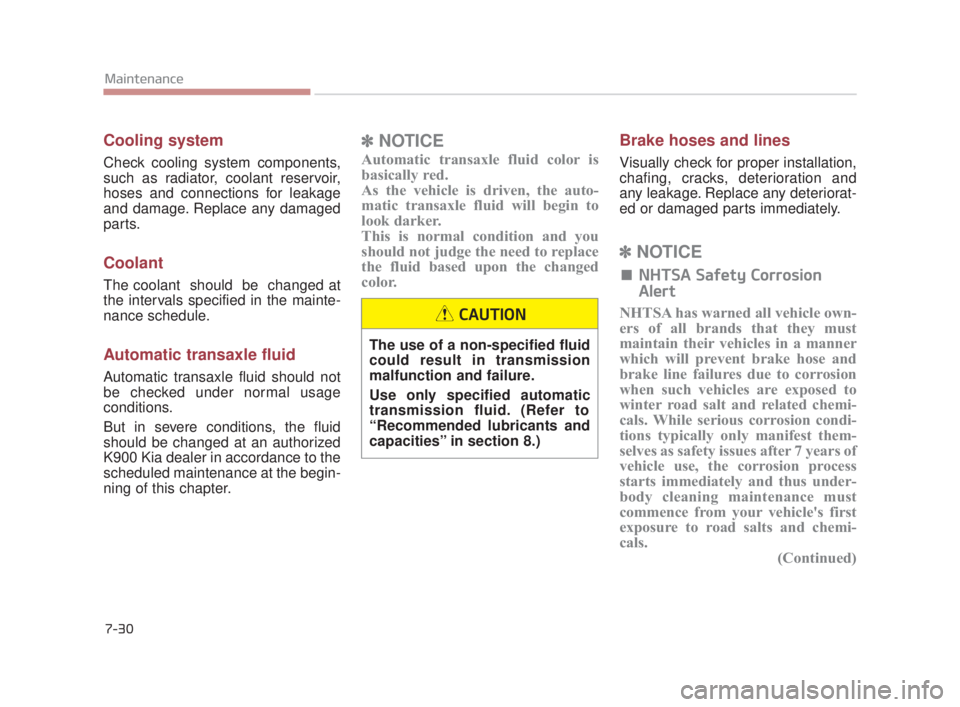
7-30
Maintenance
Cooling system
Check cooling system components,
such as radiator, coolant reservoir,
hoses and connections for leakage
and damage. Replace any damaged
parts.
Coolant
The coolant should be changed at
the intervals specified in the mainte-
nance schedule.
Automatic transaxle fluid
Automatic transaxle fluid should not
be checked under normal usage
conditions.
But in severe conditions, the fluid
should be changed at an authorized
K900 Kia dealer in accordance to the
scheduled maintenance at the begin-
ning of this chapter.
✽NOTICE
Automatic transaxle fluid color is
basically red.
As the vehicle is driven, the auto-
matic transaxle fluid will begin to
look darker.
This is normal condition and you
should not judge the need to replace
the fluid based upon the changed
color.
Brake hoses and lines
Visually check for proper installation,
chafing, cracks, deterioration and
any leakage. Replace any deteriorat-
ed or damaged parts immediately.
✽NOTICE
■ NHTSA Safety Corrosion
Alert
NHTSA has warned all vehicle own-
ers of all brands that they must
maintain their vehicles in a manner
which will prevent brake hose and
brake line failures due to corrosion
when such vehicles are exposed to
winter road salt and related chemi-
cals. While serious corrosion condi-
tions typically only manifest them-
selves as safety issues after 7 years of
vehicle use, the corrosion process
starts immediately and thus under-
body cleaning maintenance must
commence from your vehicle's first
exposure to road salts and chemi-
cals. (Continued)
The use of a non-specified fluid
could result in transmission
malfunction and failure.
Use only specified automatic
transmission fluid. (Refer to
“Recommended lubricants and
capacities” in section 8.)
CAUTION
KH USA 7:2018 4/14/2017 6:37 PM Page 30
Page 439 of 544
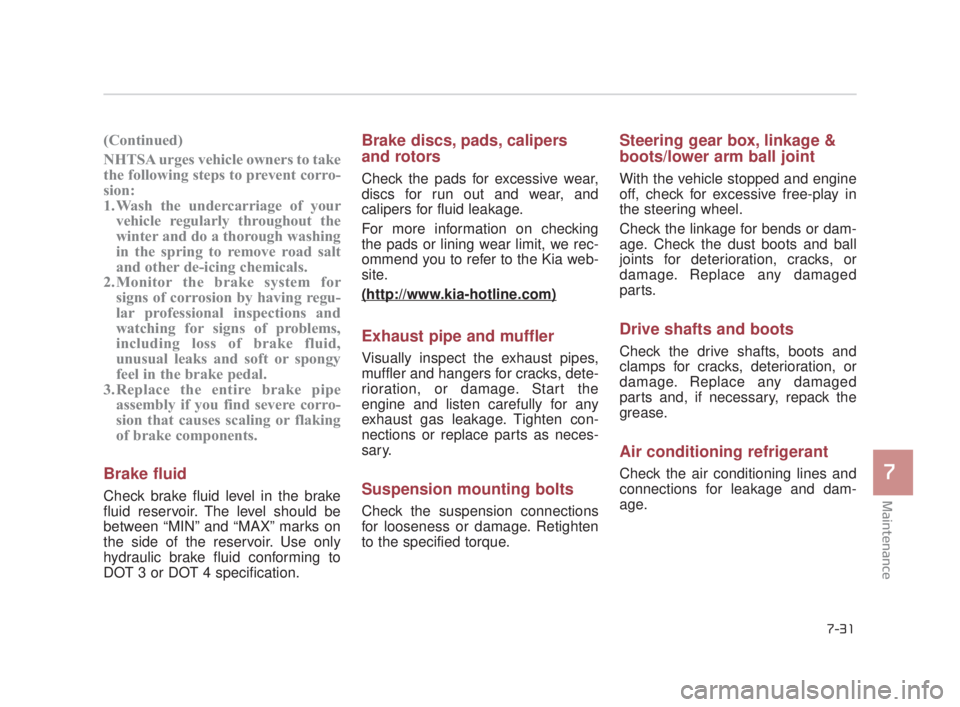
Maintenance
7
7-31
(Continued)
NHTSA urges vehicle owners to take
the following steps to prevent corro-
sion:
1. Wash the undercarriage of yourvehicle regularly throughout the
winter and do a thorough washing
in the spring to remove road salt
and other de-icing chemicals.
2.Monitor the brake system for signs of corrosion by having regu-
lar professional inspections and
watching for signs of problems,
including loss of brake fluid,
unusual leaks and soft or spongy
feel in the brake pedal.
3.Replace the entire brake pipe assembly if you find severe corro-
sion that causes scaling or flaking
of brake components.
Brake fluid
Check brake fluid level in the brake
fluid reservoir. The level should be
between “MIN” and “MAX” marks on
the side of the reservoir. Use only
hydraulic brake fluid conforming to
DOT 3 or DOT 4 specification.
Brake discs, pads, calipers
and rotors
Check the pads for excessive wear,
discs for run out and wear, and
calipers for fluid leakage.
For more information on checking
the pads or lining wear limit, we rec-
ommend you to refer to the Kia web-
site.
(http://www.kia-hotline.com)
Exhaust pipe and muffler
Visually inspect the exhaust pipes,
muffler and hangers for cracks, dete-
rioration, or damage. Start the
engine and listen carefully for any
exhaust gas leakage. Tighten con-
nections or replace parts as neces-
sary.
Suspension mounting bolts
Check the suspension connections
for looseness or damage. Retighten
to the specified torque.
Steering gear box, linkage &
boots/lower arm ball joint
With the vehicle stopped and engine
off, check for excessive free-play in
the steering wheel.
Check the linkage for bends or dam-
age. Check the dust boots and ball
joints for deterioration, cracks, or
damage. Replace any damaged
parts.
Drive shafts and boots
Check the drive shafts, boots and
clamps for cracks, deterioration, or
damage. Replace any damaged
parts and, if necessary, repack the
grease.
Air conditioning refrigerant
Check the air conditioning lines and
connections for leakage and dam-
age.
KH USA 7:2018 4/14/2017 6:37 PM Page 31
Page 440 of 544
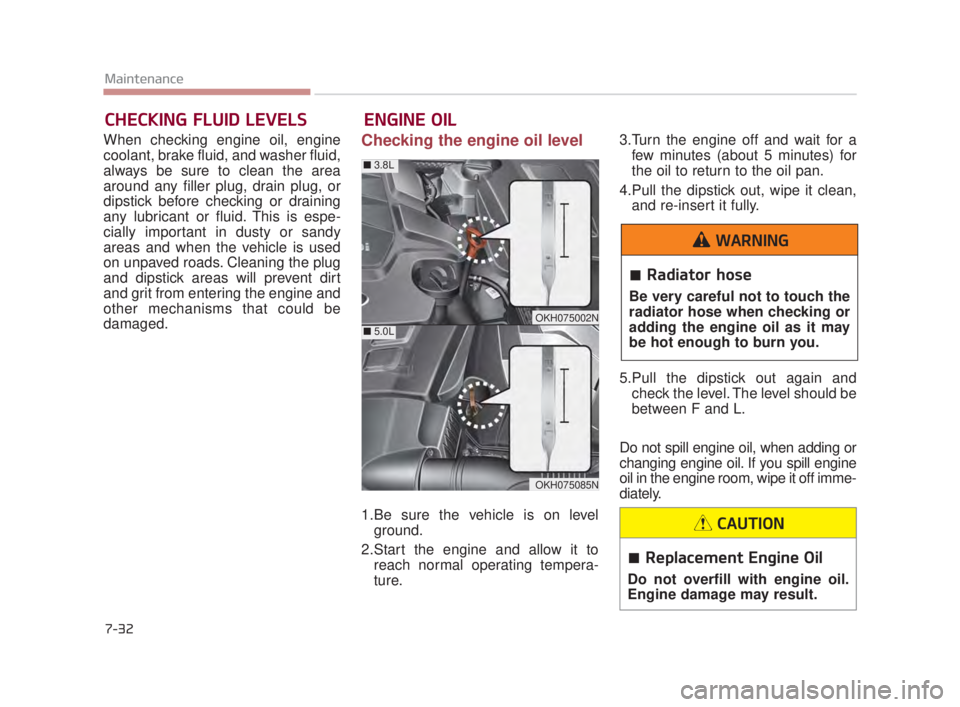
7-32
Maintenance
ENGINE OIL
CHECKING FLUID LEVELS
When checking engine oil, engine
coolant, brake fluid, and washer fluid,
always be sure to clean the area
around any filler plug, drain plug, or
dipstick before checking or draining
any lubricant or fluid. This is espe-
cially important in dusty or sandy
areas and when the vehicle is used
on unpaved roads. Cleaning the plug
and dipstick areas will prevent dirt
and grit from entering the engine and
other mechanisms that could be
damaged.Checking the engine oil level
1.Be sure the vehicle is on level
ground.
2.Start the engine and allow it to reach normal operating tempera-
ture. 3.Turn the engine off and wait for a
few minutes (about 5 minutes) for
the oil to return to the oil pan.
4.Pull the dipstick out, wipe it clean, and re-insert it fully.
5.Pull the dipstick out again and check the level. The level should be
between F and L.
Do not spill engine oil, when adding or
changing engine oil. If you spill engine
oil in the engine room, wipe it off imme-
diately.
Replacement Engine Oil
Do not overfill with engine oil.
Engine damage may result.
CAUTION
Radiator hose
Be very careful not to touch the
radiator hose when checking or
adding the engine oil as it may
be hot enough to burn you.
WARNING
OKH075002N
OKH075085N
■ 3.8L
■ 5.0L
KH USA 7:2018 4/14/2017 6:37 PM Page 32
Page 446 of 544
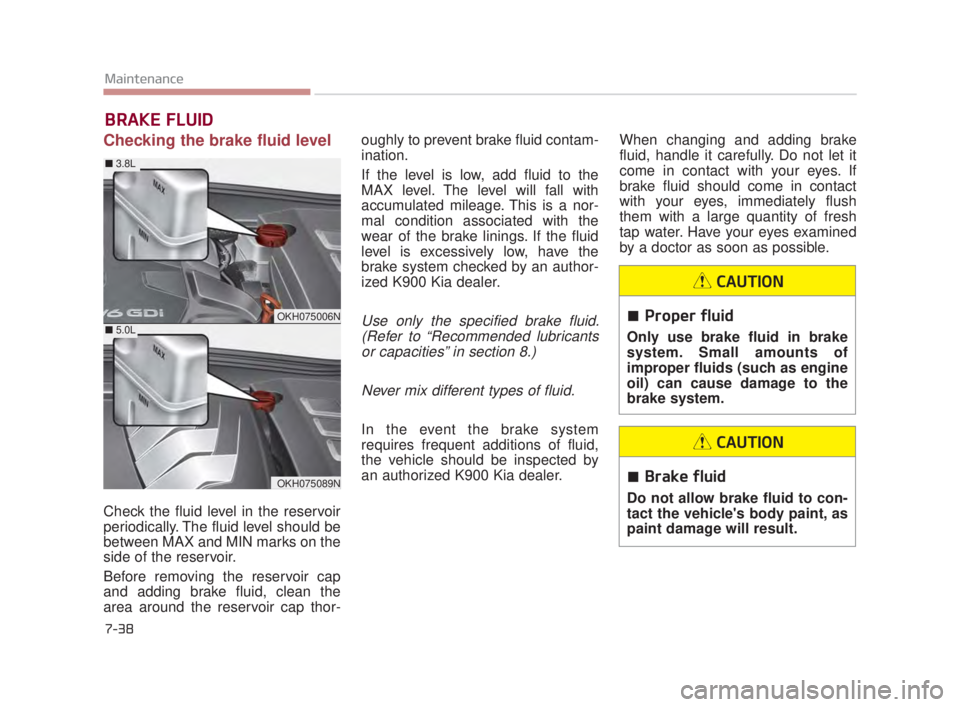
7-38
Maintenance
BRAKE FLUID
Checking the brake fluid level
Check the fluid level in the reservoir
periodically. The fluid level should be
between MAX and MIN marks on the
side of the reservoir.
Before removing the reservoir cap
and adding brake fluid, clean the
area around the reservoir cap thor-oughly to prevent brake fluid contam-
ination.
If the level is low, add fluid to the
MAX level. The level will fall with
accumulated mileage. This is a nor-
mal condition associated with the
wear of the brake linings. If the fluid
level is excessively low, have the
brake system checked by an author-
ized K900 Kia dealer.
Use only the specified brake fluid.
(Refer to “Recommended lubricantsor capacities” in section 8.)
Never mix different types of fluid.
In the event the brake system
requires frequent additions of fluid,
the vehicle should be inspected by
an authorized K900 Kia dealer. When changing and adding brake
fluid, handle it carefully. Do not let it
come in contact with your eyes. If
brake fluid should come in contact
with your eyes, immediately flush
them with a large quantity of fresh
tap water. Have your eyes examined
by a doctor as soon as possible.
Proper fluid
Only use brake fluid in brake
system. Small amounts of
improper fluids (such as engine
oil) can cause damage to the
brake system.
CAUTION
Brake fluid
Do not allow brake fluid to con-
tact the vehicle's body paint, as
paint damage will result.
CAUTION
OKH075006N
OKH075089N
■
3.8L
■ 5.0L
KH USA 7:2018 4/14/2017 6:37 PM Page 38
Page 474 of 544

7-66
Maintenance
Intended Outboard Sidewall:The
side of an asymmetrical tire, that
must always face outward when
mounted on a vehicle.
Kilopascal (kPa): The metric unit for
air pressure.
Light truck(LT) tire: A tire designat-
ed by its manufacturer as primarily
intended for use on lightweight trucks
or multipurpose passenger vehicles.
Load ratings: The maximum load
that a tire is rated to carry for a given
inflation pressure.
Load Index: An assigned number
ranging from 1 to 279 that corre-
sponds to the load carrying capacity
of a tire.
Maximum Inflation Pressure: The
maximum air pressure to which a
cold tire may be inflated. The maxi-
mum air pressure is molded onto the
sidewall. Maximum Load Rating:
The load rat-
ing for a tire at the maximum permissi-
ble inflation pressure for that tire.
Maximum Loaded Vehicle Weight:
The sum of curb weight; accessory
weight; vehicle capacity weight; and
production options weight.
Normal Occupant Weight: The
number of occupants a vehicle is
designed to seat multiplied by 150
pounds (68 kg).
Occupant Distribution: Designated
seating positions.
Outward Facing Sidewall: The side
of a asymmetrical tire that has a par-
ticular side that faces outward when
mounted on a vehicle. The outward
facing sidewall bears white lettering
or bears manufacturer, brand, and/or
model name molding that is higher or
deeper than the same moldings on
the inner facing sidewall.
Passenger (P-Metric) Tire: A tire
used on passenger cars and some
light duty trucks and multipurpose
vehicles. Ply:
A layer of rubber-coated parallel
cords
Pneumatic tire: A mechanical
device made of rubber, chemicals,
fabric and steel or other materials,
that, when mounted on an automo-
tive wheel, provides the traction and
contains the gas or fluid that sustains
the load.
Production options weight: The
combined weight of installed regular
production options weighing over 5
lb.(2.3 kg) in excess of the standard
items which they replace, not previ-
ously considered in curb weight or
accessory weight, including heavy
duty brakes, ride levelers, roof rack,
heavy duty battery, and special trim.
Recommended Inflation Pressure:
Vehicle manufacturer's recommend-
ed tire inflation pressure and shown
on the tire placard.
Radial Ply Tire: A pneumatic tire in
which the ply cords that extend to the
beads are laid at 90 degrees to the
centerline of the tread.
KH USA 7:2018 4/14/2017 6:39 PM Page 66
Page 523 of 544
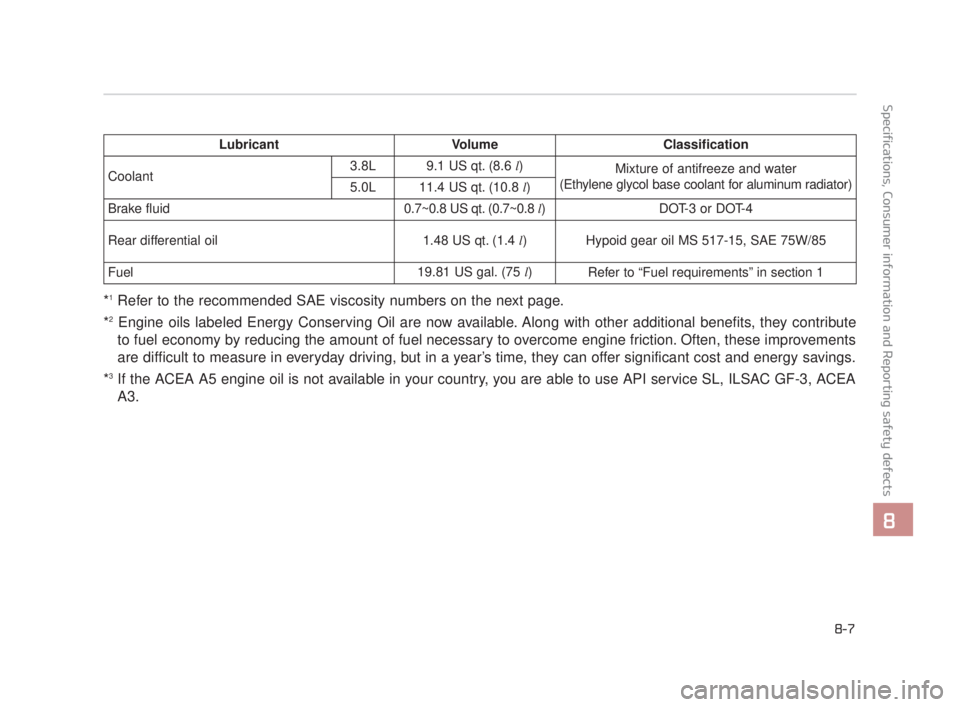
Specifications, Consumer information and Reporting safety defects
8
8-7
*1Refer to the recommended SAE viscosity numbers on the next page.
*
2Engine oils labeled Energy Conserving Oil are now available. Along with other additional benefits, they contribute
to fuel economy by reducing the amount of fuel necessary to overcome engine friction. Often, these improvements
are difficult to measure in everyday driving, but in a year’s time, they can offer significant cost and energy savings.
*
3If the ACEA A5 engine oil is not available in your country, you are able to use API service SL, ILSAC GF-3, ACEA
A3.
LubricantVolumeClassification
Coolant 3.8L9.1 US qt. (8.6 l)Mixture of antifreeze and water
(Ethylene glycol base coolant for aluminum radiator)
5.0L11.4 US qt. (10.8 l)
Brake fluid0.7~0.8 US qt. (0.7~0.8 l)DOT-3 or DOT-4
Rear differential oil1.48 US qt. (1.4 l)Hypoid gear oil MS 517-15, SAE 75W/85
Fuel19.81 US gal. (75 l)Refer to “Fuel requirements” in section 1
KH USA 8:2018 4/14/2017 6:44 PM Page 7
Page 534 of 544

Battery........................................................................\
....7-49
Battery replacement (for smart key) ................................4-9
Battery saver function ..................................................4-129
Before driving ..................................................................5-4
Blind Spot Detection System(BSD) ..............................5-86BSD (Blind Spot Detection) /LCA (Lane Change Assist) .....................................5-87
RCTA (Rear cross traffic alert) .................................5-90
Bluetooth
®Wireless Technology hands-free ...............4-182
Brake system..................................................................5-27 Autonomous emergency braking (AEB)...................5-49
Anti-lock brake system (ABS) ..................................5-41
Auto Hold ..................................................................5-37
Electric parking brake (EPB) ....................................5-31
Electronic stability control (ESC) .............................5-43
Hill-start assist control (HAC) ..................................5-47
Power brakes .............................................................5-27
Brakes fluid....................................................................7-38\
Bulb replacement ...........................................................7-89
Bulb wattage ....................................................................8-3
Button start/stop, see engine start/stop button .................5-6
Camera see the Rear-Camera Display .........................4-122
Capacities (Lubricants) ....................................................8-6
Care Exterior care ..............................................................7-96 Interior care .............................................................7-102
Tire care.....................................................................7-5\
4
Center console storage .................................................4-164
Central door lock switch................................................4-19
Certification label ........................................................5-108
Chains - Tire ................................................................5-101
Checking tire inflation pressure.....................................7-55
Child restraint system ....................................................3-32 Lower anchor system ................................................3-37
Seat belt .....................................................................3-3\
3
Child-protector rear door lock .......................................4-20
Climate control additional features .............................4-163 Cluster ionizer .........................................................4-163
Smart ventilation .....................................................4-163
Climate control air filter ................................................7-44
Clock ........................................................................\
....4-174
Clothes hanger .............................................................4-175
Combined instrument, see instrument cluster ...............4-67
Compact spare tire .........................................................6-24
Compact spare tire replacement ....................................7-59
Consumer assistance(U.S. only) ....................................8-11
Coolant ........................................................................\
...7-34
Cooling fluid, see engine coolant ..................................7-34
Crankcase emission control system .............................7-102
Cruise control system ....................................................5-62 To set cruise control speed ........................................5-63
Cup holder ...................................................................4-168\
Curtain air bag ...............................................................3-56
Index
I-3
I
C
KH USA Index:2018 4/18/2017 10:39 AM Page 3